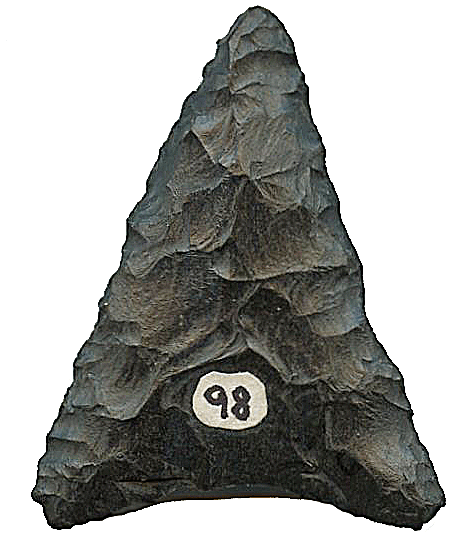
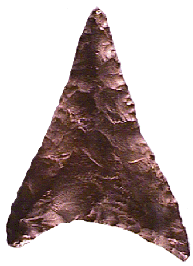
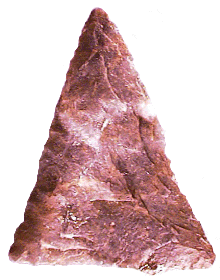



Point Type: LEVANNA
Also See: Caraway, Clarksville, Hamilton Arrow , Madison, Matamoros, Nolichucky, Yadkin, Yadkin Eared
Location: Southeastern and Northeastern United States
Associated Dates:
1300 - 600 B.P.- Woodland to Mississippian
Morphology: Lanceolate (Triangular)
General Description: The Levanna is a small to medium sized, thin, triangular lanceolate arrowhead with generally a concave and occasionally a straight base. These points are nearly as wide as they are long and are generally thin and well made. In more slender specimens, the length varies from about one and one third to one and one half times the width. About seventy percent of the time the point will be an equilateral triangle. The remainder of the population could be described as broad isosceles triangles. Edges are usually straight but can occasionally be incurvate, excurvate or recurvate. More than eighty percent of specimens will show a basal concavity, often to a marked degree and nearly V-shaped in a few examples which produce prominent corner barbs or auricles. The remaining 20 percent have straight bases.
The point has wide distribution especially in New York, Connecticut, northern New Jersey, northeastern Pennsylvania, most of New England, Southern Ontario, and into the middle Atlantic states at least as far south as Virginia. Levannas are usually made from local materials, flints, cherts, quartzites and siltstones. The Levanna is considered a characteristic arrow point of the Owasco culture.
The Levanna can range in size from 22 mm to 76 mm. The average size range is between 32 mm to 44 mm in length and the typical thickness is 9 mm. The point was named in 1928 by William A. Ritchie for the Levanna site in Cayuga County, New York.
About the Point Above (Left): The point pictured at the top left of this page (distal end pointing up) is an average sized classical example of the Levanna point with a normal concave basal edge. This specimen is made from a black flint which is highly patinated. The point measures 44 mm in length, 35.5 mm at the widest point (across the base) and is 6.5 mm thick mid blade. The point tips thin down to 3 mm in thickness. The lower right basal ear is slightly chipped. The base concavity is 4 mm deep. This point was a surface find from a cornfield near the town of Montague, Sussex County, New Jersey. Catalog Number 98-20-B
About the Point Above (Center): The point pictured at the top center of this page (distal end pointing up) is an average sized classical example of the Levanna point which has a deeply concave basal edge. This specimen is made from a black flint which is slightly patinated. The point measures 38 mm in length, 31 mm at the widest point (across the base) and is a remarkable 4 mm thick mid blade. The point tips thin down to an incredible 1.5 mm in thickness. The basal concavity is 5.5 mm deep. Overall, this Levanna is a remarkable thin point, showing fine knapping skills, a pleasingly asymmetrical outline with incurvate blade edges and a deeply concave base. This point was a surface find in a tomato field in the outskirts of town of Montague, Sussex County, New Jersey. Catalog Number 99-20-B
About the Point Above (Right): The point pictured at the top right of this page (distal end pointing up) is an average sized Levanna point which features a straight basal edge. This specimen is made from a rose quartzite with white quartz veins. The point measures 44 mm in length, 34 mm at the widest point (across the base) and is only 6 mm thick mid blade. The point tips thin down to 2.5 mm in thickness. This point was a surface find in Knapp's farm fields, near Frosh Pond, town of Stratford, Fairfield County, Connecticut. Catalog Number 97-20-B
About the Point Below (Left): The point pictured at the bottom left of this page, (distal end pointing up) is an average sized classical example of the Levanna point. This specimen is made from a white quartz which is slightly translucent. The point measures 28 mm in length, 24 mm at the widest point (across the base) and is 9 mm thick mid blade. The point tips thin down to 2.5 mm in thickness and the basal tips are translucent. The base concavity is 3 mm deep. This point was a surface find in Knapp's farm fields, near Frosh Pond, town of Stratford, Fairfield County, Connecticut.Catalog Number 43-5-B
About the Point Below (Center): The point pictured at the bottom center of this page (distal end pointing up) is an average sized classical example of the Levanna point. This specimen is made from a tannish and pinkish flint which is slightly encrusted with a patina formed while submerged in a creek. The point measures 34 mm in length, 26 mm at the widest point (across the base) and is only 4 mm thick mid blade. The point tips thin down to 2.5 mm in thickness. The base concavity is 2 mm deep. This point was a surface find in a creek bed that feeds the South Branch of the Raritan River, town of Hamden, Hunterdon County, New Jersey. Catalog Number 102-9-A
About the Point Below (Right): The point pictured below on the right of this page, (distal end pointing up) is an average sized Levanna point. This specimen is made from clear crystal quartz. The point measures 31 mm in length, 27 mm at the widest point (across the base) and is 7 mm thick mid blade. The point tips thin down to 3.5 mm in thickness. The base concavity is 2 mm deep. This point was a surface find in Knapp's farm fields, near Frosh Pond, town of Stratford, Fairfield County, Connecticut. Catalog Number 103-9-A
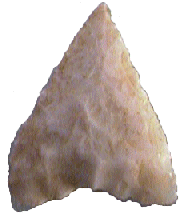
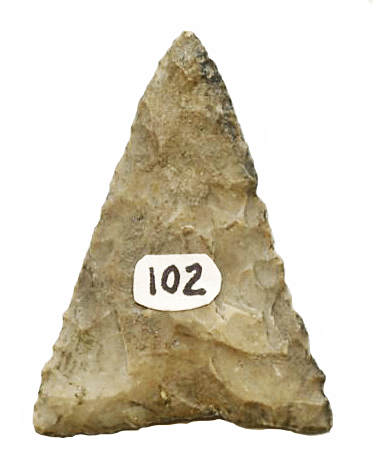
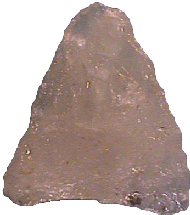
References:Dragoo (f), Fogleman, Justice, Overstreet, Perino (1), Ritchie, Waldorf
© Copyright 1997 - 2008 LITHICS-Net WWW.LITHICSNET.COM
Use Your Browser's BACK Button to Return to the LITHICS-Net Index.